NASSAU
tree is leaning
A leaning tree isn’t always dangerous, but it’s never something to ignore. Some trees grow at an angle due to one-sided sunlight or uneven soil, which is often stable and not urgent. But when a tree that was once upright begins to lean, especially after heavy rain, snow, or a storm, it’s usually a sign of root movement, soil erosion, or structural damage.
The direction of the lean matters too, if it’s toward your house, fence, car, or sidewalk, the risk increases a lot. Understanding why a tree leans is the first step in knowing what to do next.
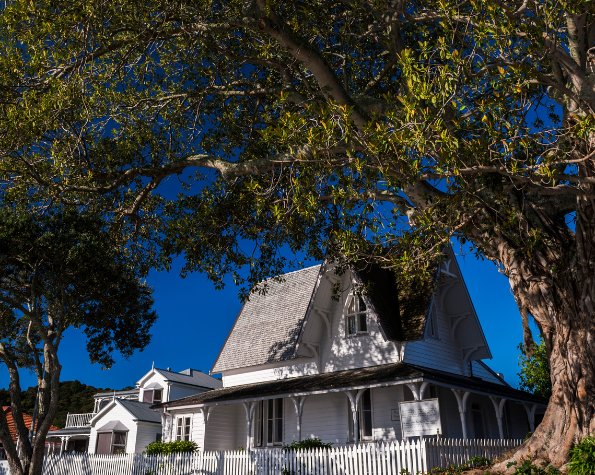
Signs Your Tree Will Lean or Fall
- The trunk is visibly leaning
- Soil is raised or cracked on one side of the base
- Roots are exposed or lifting from the ground
- The tree was straight and is now leaning
- Tree leans toward your house, car, or power line
- Neighboring trees were damaged in a storm
- The lean started after heavy rain or snow
- You hear cracking or popping sounds in wind
- The canopy is uneven or heavier on one side
- The tree is a tall species (pine, maple, oak) on a slope
- It’s planted in clay-heavy or poorly drained soil
- The tree is 20+ years and hasn’t been inspected
- Canopy looks thin or sparse compared to previous years
- Trunk base is soft, cracked, or oozing sap
- It leans more than 15 degrees from vertical
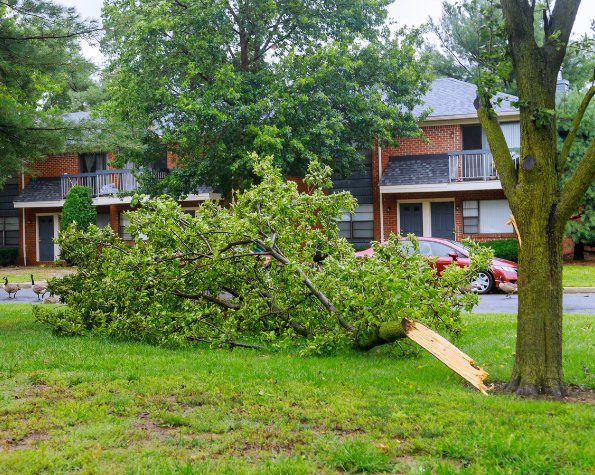
How to Tell If a Leaning Tree Is Dangerous
Not every lean is a threat. But here’s what you should look for:
- Degree of lean: More than 15 degrees from vertical is a red flag.
- Soil heave: If the ground is raised on one side, the root plate is compromised.
- Root exposure: Visible roots mean the tree is
losing its grip. - Trunk condition: Cracks, oozing, or soft spots indicate decay.
- Direction of lean: Toward a house, fence, or sidewalk is high risk.
- Species and size: Tall, shallow-rooted trees like pines are more prone to failure.
NYC Tree Types Prone To Leaning
- Pine trees: Tall with shallow root systems, pines are vulnerable to windthrow, especially in saturated soil after storms.
- Silver maple: Fast-growing but weak-wooded, silver maples are highly susceptible to storm damage and often develop leans as they mature.
- Willow: Loves moisture, so it is often planted near wet areas where soil stays soft. Saturated ground reduces root anchoring, making it more likely to shift.
- Poplar (including Lombardy): Grows quickly but develops weak structure and shallow roots. Older poplars often lean due to imbalanced canopies or root stress.
- Sycamore: Can become top-heavy as it ages. If growing on a slope or in restricted soil, the trunk may begin to tilt.
- Tulip tree: While strong when young, tulip trees grow very tall and straight. If planted too close to a house, wind resistance can push it off balance.
- Bradford / Callery pear: Known for narrow branch unions and weak structure. As one side of the canopy dies back, the imbalance pulls the tree into a lean.
- Oak (especially pin oak): Generally stable, but oaks planted in small yards with compacted soil can develop root girdling, weakening their anchor system.
- Ash: Declining due to emerald ash borer, many ash trees lose structural integrity. A sudden lean is often a sign of advanced internal decay.
- Spruce: Like pines, spruces have shallow roots and dense canopies, making them prone to leaning after snow or wind.
Why Trees Lean or Tilt
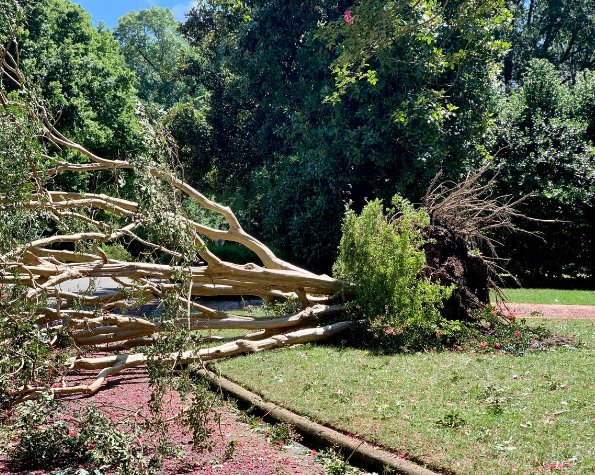
Storm Damage and Windthrow
Strong winds, heavy snow, or ice storms can push a tree off balance, especially if the soil is saturated. This is called windthrow. It’s common after nor’easters or wet spring thunderstorms. If the root plate lifts, the tree may not be salvageable and will need full tree removal services.
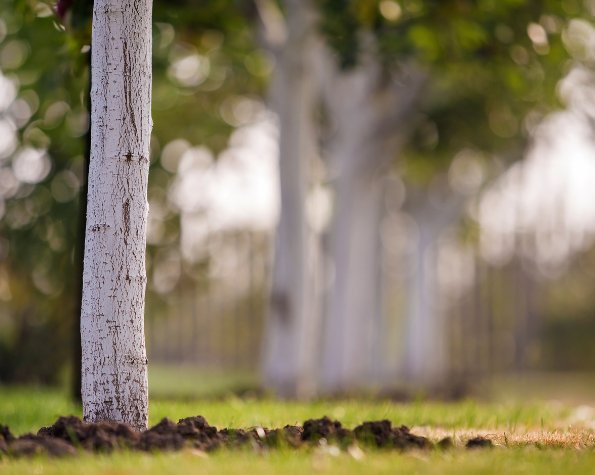
Soil Erosion or Saturation
Clay-heavy NYC soil holds a lot of water. After a prolonged rain, it becomes soft and unstable. Roots can’t anchor properly, and the tree begins to shift. This is especially common on slopes or near downspouts. If the soil stays wet for too long, even a healthy tree can start to lean.
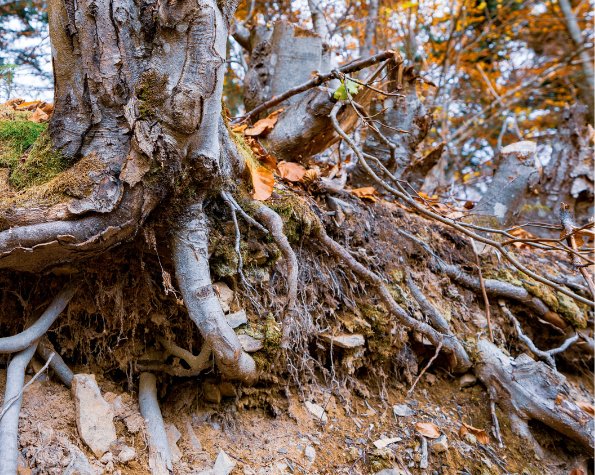
Root Damage from Construction
Excavation, paving, or utility work can cut or compact roots, weakening the tree’s stability. You might not see the damage right away. But over time, the tree loses its balance. We see this often in older neighborhoods where driveways or patios were added without considering root zones.
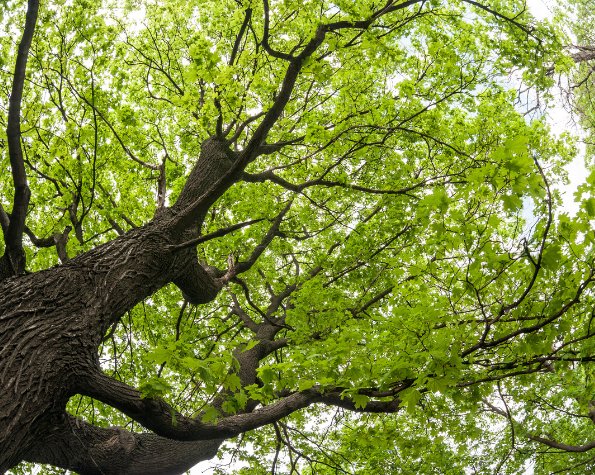
Uneven Canopy or One-Sided Growth
If a tree grows toward sunlight, say, away from a building or fence, it can develop a heavier canopy on one side. This imbalance pulls the trunk off-center. A tree with an uneven canopy is not always dangerous, but when combined with weak roots, it increases the risk of failure.
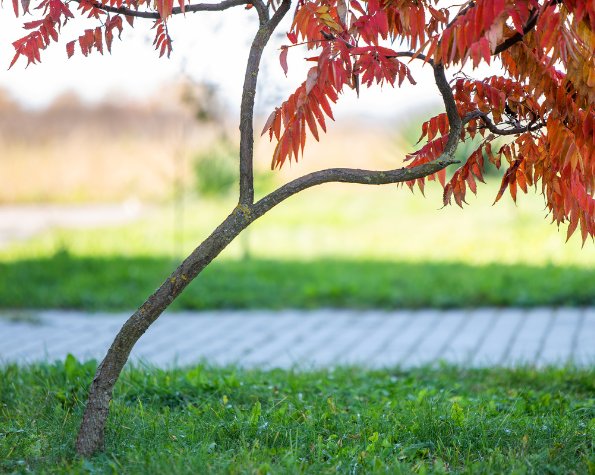
Poor Planting or Girdling Roots
Trees planted too deep or with circling roots tend to become unstable over time. Girdling roots strangle the trunk, weakening its structure. From the outside, the tree might look fine until it starts to lean. This is common in trees planted in the last 10–20 years without getting a proper root inspection.
Can a Leaning Tree Be Saved?
Sometimes. If the lean is minor, the roots are intact, and the tree is otherwise healthy, it’s possible to stabilize it in a few different ways:
Cabling and Bracing
For trees with a slight lean but strong root systems, cabling can help redistribute weight. It’s not a fix for severe leans. We only recommend this when the structure is sound and the risk is low.
Root Zone Repair
If the soil has settled or eroded, we can add structural soil or mulch to stabilize the base. This won’t straighten the tree, but it can prevent it from leaning more. It’s most effective for younger trees or those with partial root lift.
Replanting (For Young Trees)
If the tree is young (under 10 years old) and the root plate hasn’t been severely damaged, it might be possible to dig it up and replant it.
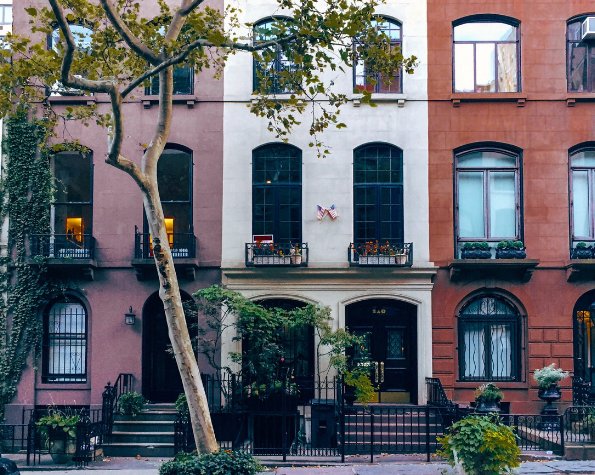
FAQs
It depends on the size, how much it is leaning, and what it is leaning towards. A slight lean on a healthy tree might not be dangerous. But if the soil is heaving, the roots are exposed, or the tree is leaning toward a structure, it could be a hazard. In New York City, where storms and wet soil are common, even a small lean can become a problem. If you’re worried about how much your tree is leaning, just give us a call, and we will come assess your tree.
Sometimes, but only if it’s young, the roots are intact, and the lean is minor. For mature trees with lifted root plates, straightening isn’t possible. Cabling can help stabilize a tree, but it won’t fix a severe lean. In most cases, if the tree is significantly off-balance, removal is the safest option.
Saturated soil and strong winds are the main culprits. When the ground is waterlogged, roots can’t hold the tree in place. The wind pushes it over, and the root plate lifts. This is called windthrow. If the roots are still attached and the lean is less than 15 degrees, the tree might survive. But if the root plate is broken, it’s likely to fall in the next storm.
Homeowners insurance often covers damage to your house or car from a fallen tree, but not the cost of removal unless it’s blocking access. If the tree was already leaning or diseased and you didn’t address it, the claim could be denied. That’s why it’s important to have risky trees inspected and documented. We can provide a professional assessment for your records.
Not if it’s leaning toward a structure. Waiting increases the risk of damage or injury. A tree that’s already shifting is more likely to fall in the next storm. We recommend acting quickly either with stabilization or removal.
Some slight movement is normal. A slight lean with no soil heave or exposed roots might just be temporary settling. But if the ground is raised on one side, roots are lifting, or the tree wasn’t leaning before, it’s a red flag.
Not safely, and not long-term. Tying a leaning tree to another tree puts stress on both trees and can cause bark damage, disease, or even pull the second tree over. Using stakes or posts only works for small, young trees with flexible trunks and intact root balls.
For anything larger, DIY fixes won’t hold and can make the tree worse by restricting natural movement or damaging the bark. If the lean is serious, proper cabling or removal is the responsible move.
CONTACT GREENLEAF TODAY!
We’ve been helping NYC homeowners assess leaning, tilting and unstable trees for over four decades. We’ll come to your yard, inspect the tree and the surrounding area, and tell you what’s really going on.
